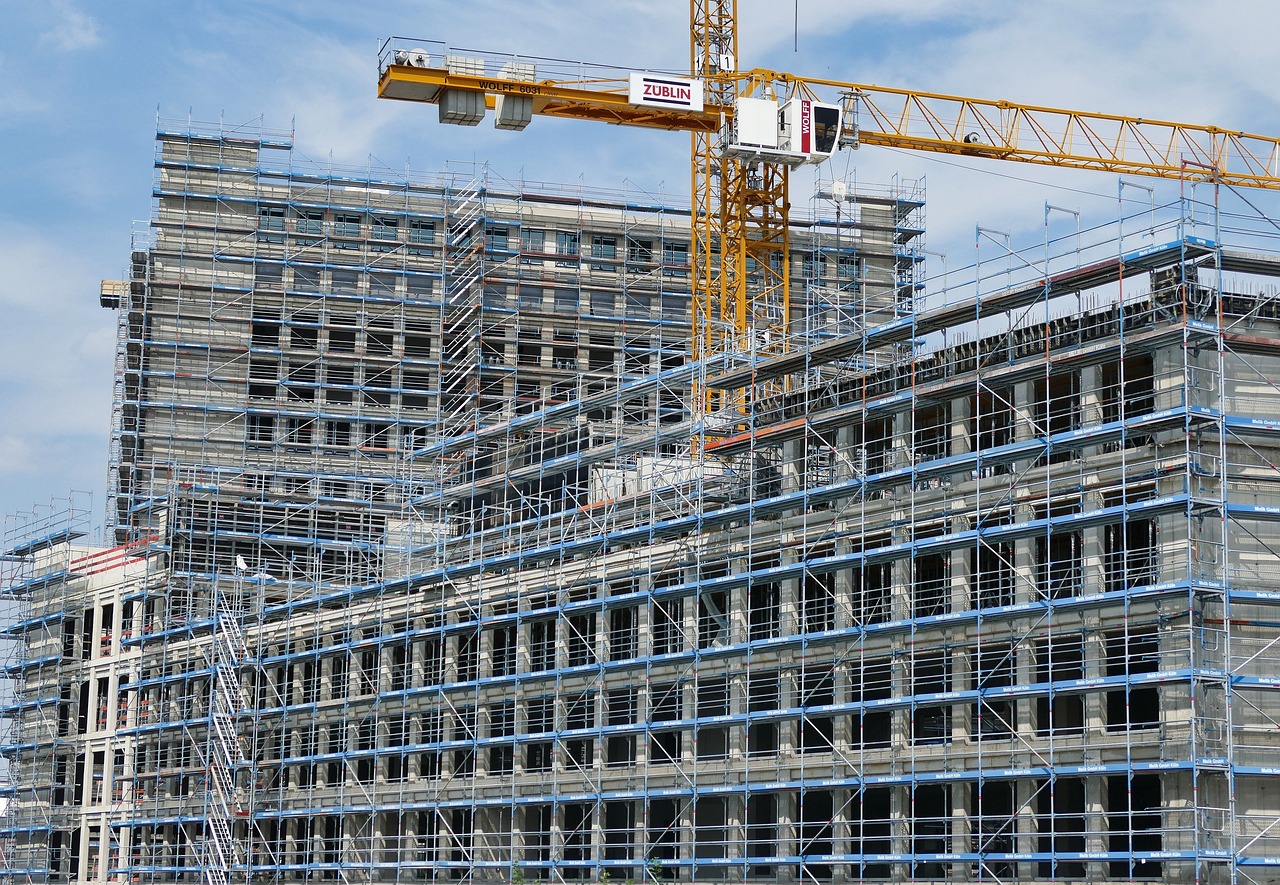Commercial Drywall Estimating Services
Build-Outs
 Optimized Guide to Commercial Heavy Gauge Build-Outs
Optimized Guide to Commercial Heavy Gauge Build-Outs
Introduction
A commercial heavy gauge build-out is an essential component of large-scale construction, providing the structural framework for retail spaces, office buildings, warehouses, and industrial facilities. These projects require precise planning, high-quality materials, and expert execution to ensure safety, durability, and compliance with local building codes.
In this guide, we’ll explore everything you need to know about heavy gauge metal framing, including its materials, installation process, key benefits, challenges, and considerations for commercial construction projects. Whether you are a contractor, estimator, or developer, this article will equip you with expert knowledge to optimize your build-out projects effectively.
What Is a Commercial Heavy Gauge Build-Out?
A commercial heavy gauge build-out refers to the use of high-strength steel framing in the construction of a commercial building’s interior and exterior structural framework. Unlike light gauge steel, which is typically used for non-load-bearing partitions and interior walls, heavy gauge steel framing is engineered for applications requiring greater structural integrity and load-bearing capacity. This makes it a preferred choice for commercial projects where durability, stability, and long-term performance are critical.
Heavy gauge steel framing is commonly used in the construction of mid-rise and high-rise buildings, office complexes, retail spaces, healthcare facilities, and industrial structures. Its ability to support significant loads makes it essential for applications such as mezzanines, roof structures, and multi-story framing. Unlike traditional wood framing, heavy gauge steel offers enhanced fire resistance, superior resistance to moisture and pests, and a longer lifespan, making it an ideal solution for demanding commercial environments.
One of the defining characteristics of heavy gauge steel is its thickness, which typically ranges from 12 to 20 gauge, depending on the structural requirements of the project. This thickness allows it to withstand lateral and vertical forces, ensuring the integrity of the structure even under heavy occupancy loads and environmental stresses. The precision of factory-manufactured steel components also ensures consistency in quality, reducing the likelihood of warping, shrinking, or defects commonly associated with traditional framing materials.
The installation of a heavy gauge build-out requires skilled labor and precise engineering to ensure all structural elements are correctly aligned and properly fastened. Advanced construction methods, such as prefabricated steel panelization, are often employed to improve efficiency, reduce waste, and accelerate the build process. In many cases, heavy gauge steel framing is integrated with other construction materials, such as concrete or masonry, to enhance overall strength and stability.
Contractors and developers often choose heavy gauge steel framing for its cost-effectiveness over the long term. While the initial material cost may be higher than wood or light gauge framing, the reduced need for repairs, maintenance, and replacements makes it a financially sound investment. Additionally, its compatibility with sustainable building practices makes it an attractive option for projects aiming to meet energy efficiency and environmental standards.
A commercial heavy gauge build-out is not just about strength—it’s about creating a structure that meets modern commercial demands while ensuring long-lasting performance. Whether used in large-scale tenant improvements, multi-story office developments, or high-end retail projects, heavy gauge steel framing provides the reliability and durability required to support the evolving needs of commercial construction.
Common Applications for Heavy Gauge Build-Outs
Heavy gauge steel framing is essential in commercial construction projects that require superior structural integrity, fire resistance, and durability. Its ability to support significant loads while maintaining flexibility in design makes it the preferred choice for various applications. Here are the most common uses for heavy gauge build-outs:
Retail Stores and Shopping Centers
Large retail stores, strip malls, and shopping centers benefit from heavy gauge steel framing due to its ability to support expansive, open-concept layouts. Retail environments require wide, column-free spaces to enhance customer flow and maximize floor space for product displays. Steel framing allows for the installation of large storefront windows, signage, and decorative facades, making it an ideal choice for modern retail construction. Additionally, steel’s fire resistance is a major advantage in high-traffic commercial spaces where safety regulations are stringent.
Office Buildings and Corporate Campuses
Heavy gauge steel is widely used in the construction of high-rise and mid-rise office buildings, providing the structural support necessary for multi-story framing and load-bearing partitions. Modern office layouts often require flexible interior configurations, and steel framing makes it easier to reconfigure spaces as tenant needs evolve. Additionally, its resistance to mold and moisture makes it well-suited for office environments that rely on extensive HVAC systems. Acoustic insulation can also be integrated with steel framing to create quiet, professional workspaces.
Industrial Facilities and Warehouses
Warehouses, manufacturing plants, and distribution centers demand heavy-duty framing solutions capable of withstanding significant structural loads. Heavy gauge steel framing provides the necessary strength to support large roof spans, mezzanines, overhead cranes, and heavy shelving systems. Industrial facilities are often exposed to fluctuating temperatures, heavy vibrations, and potential chemical exposure, making corrosion-resistant galvanized steel an ideal choice for long-term performance. The ability to accommodate large door openings and high ceilings further enhances the functionality of steel-framed industrial buildings.
Mixed-Use Developments
Mixed-use buildings that combine retail, office, and residential spaces require structural solutions that can support multiple occupancy types within a single development. Heavy gauge steel framing is ideal for these projects due to its high load-bearing capacity and fire-resistant properties. For example, a building with retail stores on the ground level, office spaces on the middle floors, and residential units above requires a strong and durable framing system that complies with both commercial and residential building codes. Steel framing ensures that the structure remains stable and safe, regardless of the varying occupancy requirements within the building.
Healthcare Facilities and Hospitals
Hospitals, medical offices, and healthcare facilities require stringent construction standards to ensure patient safety and regulatory compliance. Heavy gauge steel framing is used in these structures due to its ability to support specialized medical equipment, HVAC systems, and fire-resistant partitions. The non-combustible nature of steel helps meet strict fire safety codes, while its durability ensures that critical healthcare infrastructure remains intact over time. Additionally, hospitals often incorporate seismic-resistant design elements, making steel framing a preferred choice in regions prone to earthquakes.
Educational Institutions and Campus Buildings
Schools, universities, and research facilities rely on heavy gauge steel framing for the construction of classrooms, lecture halls, and laboratories. These buildings must accommodate large occupancy loads while adhering to strict safety and energy efficiency standards. Steel framing allows for flexible design layouts, enabling educational institutions to expand or reconfigure their spaces as enrollment numbers change. The material’s fire resistance and ability to integrate with acoustic insulation also contribute to a safe and comfortable learning environment.
Hospitality and High-Rise Residential Buildings
Hotels, resorts, and apartment complexes require durable construction materials that can withstand heavy daily use while offering design flexibility. Heavy gauge steel framing is commonly used in hospitality construction due to its ability to support multi-story designs, long roof spans, and custom architectural features. The use of prefabricated steel components can also accelerate construction timelines, reducing labor costs and minimizing disruptions in high-traffic urban areas. Fire-rated steel framing is particularly important in hotels and residential towers, where safety and compliance with building codes are critical.
Government and Institutional Buildings
Courthouses, police stations, fire departments, and other government buildings require long-lasting construction solutions that meet strict security and safety standards. Heavy gauge steel framing provides the strength needed for reinforced structures, while its non-combustible nature ensures compliance with fire safety regulations. Additionally, government projects often require buildings to be energy-efficient and environmentally sustainable, making steel framing an attractive choice for green building certifications.
Heavy gauge steel build-outs are essential for commercial projects that demand durability, fire resistance, and long-term cost savings. Whether used in retail spaces, office towers, warehouses, or mixed-use developments, steel framing provides the strength and flexibility necessary for modern construction. Its ability to support large spans, integrate with energy-efficient materials, and withstand environmental forces makes it the preferred choice for a wide range of applications in the commercial construction industry.
Key Components of a Heavy Gauge Build-Out
A successful heavy gauge build-out incorporates a range of materials beyond just steel framing. Each component plays a critical role in ensuring the efficiency, durability, and safety of the structure. The materials and systems used in these projects must be carefully selected to meet structural, environmental, and regulatory requirements while ensuring long-term performance.
Steel Studs and Tracks
Steel studs form the vertical framework of walls, while tracks act as the horizontal base and top supports. These elements are the foundation of any heavy gauge build-out, providing the framework for both interior and exterior walls. The type and thickness of steel used in these framing systems depend on various factors, such as the height of the structure, load requirements, and environmental conditions.
For example, in high-rise buildings or areas subject to high wind loads, thicker and more durable studs (typically 12-gauge or 14-gauge) are used to provide greater strength and rigidity. Conversely, lighter gauge steel, such as 16-gauge, is sufficient for interior non-load-bearing partitions. The use of steel studs and tracks offers advantages over traditional wood framing, including greater fire resistance, resistance to moisture and pests, and overall structural integrity.
Bracing and Reinforcement Components
To maintain rigidity and prevent movement, heavy gauge steel framing systems incorporate additional reinforcement elements. These reinforcements are essential for withstanding lateral and vertical loads, particularly in multi-story buildings and areas prone to seismic activity. Key bracing and reinforcement components include:
Bridging and Blocking – Horizontal bracing is installed between steel studs to prevent rotation and bowing. This reinforcement enhances wall stiffness and overall stability, particularly in taller wall assemblies.
Angle Clips and Brackets – These are used to secure connections at critical joints, such as where walls meet ceilings or floors. Angle clips help distribute loads evenly, reducing stress on individual framing components.
Shear Walls and Lateral Bracing – Shear walls are reinforced with structural sheathing or steel panels to resist seismic and wind forces. Lateral bracing, such as diagonal bracing or strap bracing, helps maintain structural integrity by preventing racking or shifting due to external forces.
Proper reinforcement of steel framing is crucial for ensuring the longevity and resilience of the structure, particularly in commercial and industrial applications.
Thermal and Acoustic Insulation
Since steel is a conductor of heat and sound, insulation materials are integrated into build-outs to improve energy efficiency and noise control. Proper insulation not only enhances occupant comfort but also contributes to compliance with building codes and energy efficiency standards. Common insulation types used in heavy gauge steel framing include:
Fiberglass Batts – Placed within steel stud cavities, fiberglass batts provide effective thermal insulation and reduce heat transfer through walls.
Mineral Wool – Known for its superior fire resistance and acoustic properties, mineral wool is commonly used in high-performance wall assemblies where sound attenuation and fire safety are critical.
Spray-Applied Insulation – This type of insulation is used to enhance air sealing and moisture resistance, particularly in exterior walls. Spray foam insulation can also help reduce thermal bridging, a common issue in steel-framed structures.
By incorporating the right insulation materials, commercial buildings can achieve better energy efficiency, improved acoustics, and compliance with fire safety regulations.
Fire-Rated Drywall and Gypsum Board
To meet fire safety regulations, heavy gauge build-outs require Type X or Type C fire-rated drywall. These gypsum boards contain fire-resistant additives that slow the spread of flames in the event of a fire. The thickness and number of layers of drywall used depend on fire rating requirements. For example, in high-risk environments such as hospitals or industrial facilities, multiple layers of fire-rated drywall may be installed to enhance protection.
Type C drywall is an advanced version of Type X and offers superior fire resistance due to its enhanced core composition. This makes it an ideal choice for high-risk areas that require extended fire ratings.
Ceiling Systems and Acoustic Panels
Many commercial buildings require specialized ceiling systems for acoustics, aesthetics, and functionality. Ceiling systems play a crucial role in sound control, thermal efficiency, and overall interior design. Common ceiling components in heavy gauge build-outs include:
Drop Ceiling Grids – Used for suspended ceiling panels in office buildings, schools, and hospitals. These systems provide easy access to mechanical, electrical, and plumbing systems concealed above the ceiling.
Acoustic Ceiling Tiles – Designed to improve noise reduction and sound absorption, these tiles help create a comfortable environment in spaces such as conference rooms, classrooms, and medical facilities.
Structural Ceiling Joists – Required for supporting heavy ceiling loads, such as HVAC ductwork, lighting systems, and fire suppression systems. These joists ensure that the ceiling structure remains secure and stable.
Weather Barriers and Vapor Retarders
To protect steel framing from moisture infiltration and corrosion, commercial build-outs incorporate weather-resistant barriers. Proper moisture control is essential for preventing structural damage, mold growth, and energy loss. Common moisture management components include:
House Wrap and Air Barriers – These materials help prevent wind-driven rain and moisture from penetrating walls while allowing trapped moisture to escape, reducing the risk of condensation buildup.
Vapor Retarders – Designed to control humidity levels within the building envelope, vapor retarders minimize the risk of mold growth and material degradation by limiting the passage of water vapor.
Exterior Sheathing – Provides an additional layer of protection before applying final exterior finishes. Common sheathing materials include gypsum-based boards, fiber cement panels, and rigid foam insulation.
By implementing these moisture control measures, commercial structures can maintain their integrity and energy efficiency over time.
Fasteners, Clips, and Anchors
The final essential components of a heavy gauge build-out are the fastening and anchoring materials that hold everything together. These elements ensure structural stability and compliance with industry standards. Key fastening components include:
Self-Tapping Screws – Used for securing steel studs, tracks, and bracing elements. These screws are designed to penetrate metal without requiring pre-drilling, improving installation efficiency.
Masonry Anchors and Expansion Bolts – Provide solid connections between steel framing and concrete or masonry walls. These anchors are essential for securing load-bearing elements and ensuring stability in high-stress areas.
Deflection Clips – Allow for movement in multi-story buildings while preventing structural damage. These clips accommodate building movement due to temperature changes, wind forces, and seismic activity.
A heavy gauge build-out involves a comprehensive system of steel framing, reinforcement components, insulation, fire-rated materials, ceiling systems, moisture barriers, and fastening solutions. Each component plays a vital role in ensuring the structural integrity, energy efficiency, and safety of the building. By following industry best practices and using high-quality materials, commercial construction projects can achieve long-term performance while meeting building code requirements and environmental standards.
Heavy Gauge Build-Out Process
Planning and Design
- Review architectural and engineering plans.
- Conduct load calculations and wind/seismic analysis.
- Determine material specifications and compliance with UL Listings & ASTM standards.
Material Procurement
- Order cold-formed steel framing per structural drawings.
- Secure required fasteners, anchors, and insulation.
Framing Installation
- Install track and studs based on layout drawings.
- Secure bracing and blocking for structural reinforcement.
- Ensure proper alignment, plumb, and level tolerances.
Utility Integration
Coordinate MEP (mechanical, electrical, plumbing) penetrations
Install fire stopping and insulation per code requirements.
Drywall & Finishing
- Apply fire-rated drywall (Type X or C).
- Finish joints and apply texture/paint per Level 5 finish requirements.
Final Inspections & Handover
- Conduct quality control checks.
- Perform structural and fire resistance inspections.
- Hand over project documentation and close out build-out phase.
Benefits of Heavy Gauge Build-Outs
Structural Strength & Durability
- Load-bearing capacity meets or exceeds seismic and wind load standards.
- Non-combustible and corrosion-resistant for long-term reliability.
Design Flexibility
- Allows for open floor plans and high ceilings.
- Compatible with custom finishes, cladding, and glazing systems.
Safety & Code Compliance
- Fire-resistant materials improve building safety.
- Meets stringent IBC, ASTM, and UL standards.
Cost-Effectiveness
- Lower maintenance costs compared to wood framing.
- Faster installation reduces overall labor costs.
Challenges and Considerations
Installation Complexity
- Requires skilled labor and specialized equipment.
- Precision is crucial to avoid misalignment and structural issues.
Cost Considerations
- Material costs are higher than wood but provide long-term ROI.
- Special tools and equipment increase upfront investment.
Integration with Existing Structures
- Retrofitting requires structural evaluation.
- Load transfer must be carefully assessed to prevent failure points.
Regulatory Compliance & Inspections
- Strict adherence to building codes and UL fire-rated assemblies.
- Requires documentation for material specifications and installation procedures.
Specification Sections for Heavy Gauge Build-Outs
Commercial build-out projects must adhere to key sections of the Construction Specifications Institute (CSI) MasterFormat, which organizes construction materials and methods into standardized divisions. The most relevant divisions for heavy gauge steel framing include Division 5 (Metals), Division 7 (Thermal & Moisture Protection), and Division 9 (Finishes). These divisions specify the requirements for structural integrity, energy efficiency, fire protection, and interior finishes, ensuring compliance with industry standards and building codes.
Division 05 – Metals
054000 – Heavy Gauge Steel Stud Framing
This section governs the materials and construction methods for heavy gauge steel framing systems, including both load-bearing and non-load-bearing applications. Key considerations include:
- Load-Bearing & Non-Load-Bearing Walls – Heavy gauge steel studs (typically 12-16 gauge) are selected based on the structural load requirements of the build-out. Load-bearing walls provide primary structural support, while non-load-bearing walls serve as partitions.
- Wind Load & Seismic Resistance – Framing must comply with ASCE 7-16 for lateral loads, particularly in hurricane- and earthquake-prone regions. Shear walls and bracing elements enhance structural stability.
- Fastening Methods – Connections between steel members use:
- Welded joints for high-strength applications.
- Bolted connections for modular and high-load areas.
- Screw-Fastened systems for efficient field assembly.
- Bridging, Backing, & Shear Wall Reinforcements – Steel bridging, clip angles, and cold-rolled channels prevent stud twisting and increase overall rigidity.
- Equipment & Lifting Considerations – Heavy gauge installations often require cranes, scissor lifts, and hoisting equipment, particularly for multi-story structures or long-span framing components.
Division 07 – Thermal & Moisture Protection
072000 – Thermal & Sound Batt Insulation
This section covers insulation materials designed to enhance energy efficiency, fire protection, and soundproofing within steel-framed walls and ceilings.
- Rigid Foam Insulation – Provides high R-values for exterior walls while maintaining structural integrity.
- Mineral Wool Insulation – Offers superior fire resistance (non-combustible) and sound absorption, commonly used in party walls, shaft walls, and mechanical rooms.
- Spray-Applied Insulation – Used for irregular cavities, improving thermal performance and air sealing.
- Fire Ratings & Vapor Barrier Requirements – Insulation must meet NFPA 285 (fire resistance in exterior walls) and ASTM E96 (vapor permeability requirements) to prevent condensation and mold growth.
- Acoustic Performance for Office & Retail Spaces – Sound Transmission Class (STC) ratings are considered for walls separating workspaces, with STC 50+ required for high-performance soundproofing.
Division 09 – Finishes
092500 – Gypsum Board Assemblies
This section covers drywall products and installation methods for interior commercial applications, ensuring proper fire protection, moisture resistance, and soundproofing.
Fire-Rated Drywall –
- Type X (5/8” thick) – Standard fire-rated gypsum board, providing one-hour fire resistance per layer.
- Type C – Enhanced fire resistance and shrinkage control, required for higher-rated assemblies.
Impact-Resistant & Abuse-Resistant Drywall – Designed for high-traffic areas such as hospitals, schools, and retail environments, featuring reinforced core technology to withstand dents and impacts.
- Moisture-Resistant Drywall (Green & Blue Board) –
- Green board – Standard mold- and moisture-resistant drywall for bathrooms and kitchens.
- Blue board – Specifically formulated for veneer plaster applications, offering a smooth, hard finish.
- Level 5 Finish –A high-performance finish achieved by applying a skim coat over the entire surface, recommended for critical lighting conditions and high-end commercial spaces to prevent joint visibility.
092500 – Light Gauge Steel Stud Framing
Light gauge steel studs provide a non-combustible, high-strength, and dimensionally stable alternative to traditional wood framing. These cold-formed steel members are used in interior partitions, soffits, and ceilings.
Non-Load-Bearing & Load-Bearing Partitions –
- 25-20 gauge steel studs for standard non-structural interior partitions.
- 18-12 gauge steel studs for structural interior walls requiring additional load capacity.
- Shaft Wall & Chase Wall Systems –
- Shaft wall assemblies – Used in elevator shafts and stairwells, integrating fire-resistant liner panels within a C-H stud system.
- Chase wall systems – Designed for mechanical chases and plumbing enclosures, allowing easy access for maintenance.
- Deflection Track Systems – Accommodate building movement in multi-story structures, allowing for vertical displacement without compromising wall integrity.
- Bracing & Bridging – Cold-rolled channels and bridging clips improve stability and prevent stud rotation in tall walls.
- Fire & Sound-Rated Assemblies – Installed in conjunction with gypsum board to meet STC (Sound Transmission Class) and UL fire ratings.
- Soffit & Ceiling Framing – Used for drop soffits, light coves, and specialty ceiling designs, providing a stable substrate for drywall finishes.
095100 – Acoustical Ceilings
Ceiling systems in commercial spaces are designed for aesthetics, acoustics, and functionality.
- Suspended Ceiling Grid Systems – Used for drop ceilings, allowing integration of lighting, HVAC ducts, and fire sprinklers.
- Acoustic Ceiling Tiles (ACT) – Improve sound control in office environments, classrooms, and healthcare facilities.
- Metal Panel Ceilings – Provide a modern aesthetic with enhanced durability, often used in high-end retail and hospitality projects.
- Seismic Bracing for Ceilings – Required in regions with seismic activity to prevent ceiling failure during earthquakes.
Conclusion
A commercial heavy gauge build-out is a multi-faceted process that requires precise coordination of materials and construction techniques to ensure structural integrity, energy efficiency, fire safety, and aesthetic appeal. By adhering to CSI MasterFormat specifications, contractors and estimators can ensure that all components—steel framing, insulation, drywall, and ceiling systems—meet or exceed industry standards. Understanding these divisions helps streamline project planning, improve cost-efficiency, and ensure compliance with building codes, ultimately leading to a high-quality commercial space that is both functional and durable.
For professional drywall estimating services, steel framing takeoffs, or acoustic ceiling estimations,
Contact 5280 Estimating for expert solutions tailored to your project’s needs.


